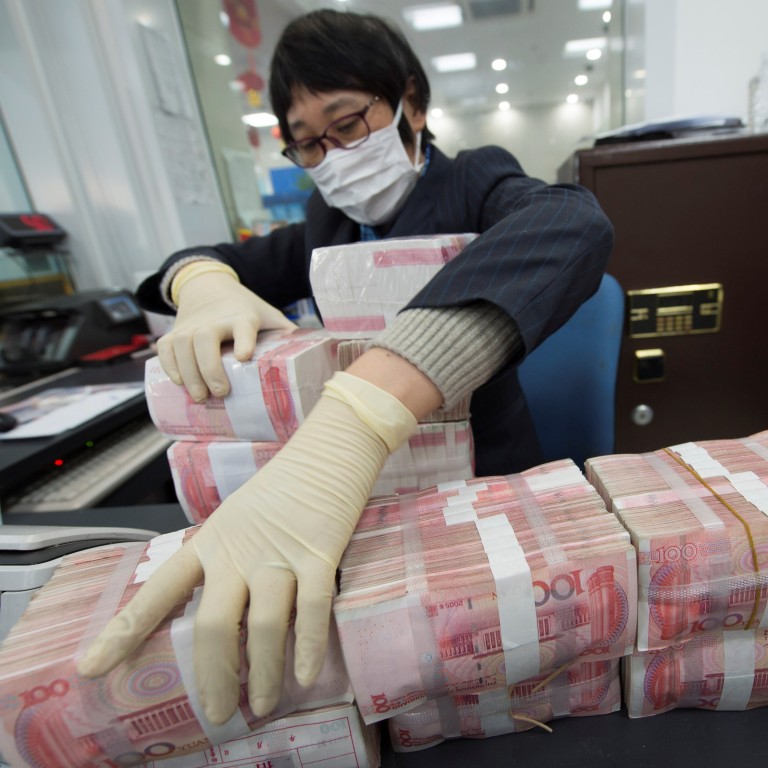
China economy: banks extended record 3.58 trillion yuan in new loans in January
- Chinese banks made a record 3.58 trillion yuan (US$555 billion) in new loans in January, up from 1.26 trillion yuan in the previous month and 3.34 trillion yuan a year earlier
- Broad M2 money supply in January grew 9.4 per cent from a year earlier, central bank data showed on Tuesday
China’s new bank loans surged to new highs in January boosted by seasonal demand, while broad credit growth slowed, as the central bank walks a tightrope between supporting a recovering economy and rising debt risks.
Banks extended 3.58 trillion yuan (US$555 billion) in new loans in January, hitting the highest on record and topping the 3.34 trillion yuan seen in January 2020, according to data released by the People’s Bank of China (PBOC) on Tuesday.
Chinese lenders tend to front-load loans at the beginning of the year to get higher-quality customers and win market share.
January’s net new credit figures are usually the highest of the year, so this high level doesn’t signify much. It makes more sense to focus on the year-on-year change in the outstanding amounts to gauge the underlying trend
“January’s net new credit figures are usually the highest of the year, so this high level doesn’t signify much. It makes more sense to focus on the year-on-year change in the outstanding amounts to gauge the underlying trend. On this basis, bank loan growth slowed from 12.8 per cent year on year to 12.7 per cent,” said economists Sheana Yue and Mark Williams from Capital Economics.
“Non-bank financing eased as well. Equity issuance picked up slightly (this is part of aggregate financing to the real economy, though not credit) and so did shadow credit, fractionally. But this was not enough to offset a further slowdown in issuance of corporate bonds and a drop back in government bond issuance as local government quotas weren’t renewed. Overall, growth in outstanding [aggregate financing to the real economy] slowed from 13.3 per cent year on year to 13.0 per cent.”
Demand for cash is usually strong ahead of the week-long Lunar New Year holiday, but market rates have pulled back from multi-year highs hit earlier this month as signs of liquidity tension in the interbank money markets started to ease.
China will avoid a sudden shift of monetary policy, the central bank said on Monday, adding that it will balance economic recovery with preventing risks.
The central bank will scale back support for the economy in 2021 and cool credit growth, but fears of derailing the recovery and debt defaults are likely to prevent it from tightening any time soon, policy sources have said.
January also saw some commercial banks in bigger cities sharply slow the issuance of property loans and mortgages amid tight credit quotas, following stringent loan caps instituted by the central bank to contain the flow of funds into the real estate sector.
Household loans, mostly mortgages, jumped to 1.27 trillion yuan in January from 563.5 billion yuan in December, while corporate loans soared to 2.55 trillion yuan from 595.3 billion yuan, according to Reuters calculation based on central bank data.
Broad M2 money supply in January grew 9.4 per cent from a year earlier, the data showed, below estimates of 10 per cent in the Reuters poll. It rose 10.1 per cent in December.
Outstanding yuan loans grew 12.7 per cent from a year earlier compared with 12.8 per cent growth in December. Analysts had expected 12.7 per cent growth.
Annual growth of outstanding total social financing (TSF), a broad measure of credit and liquidity in the economy, slowed to 13 per cent in January from 13.3 per cent in December.
TSF includes off-balance sheet forms of financing that exist outside the conventional bank lending system, such as initial public offerings, loans from trust companies and bond sales.
In January, TSF jumped to 5.17 trillion yuan from 1.72 trillion yuan in December. Analysts polled by Reuters had expected January TSF of 4.45 trillion yuan.

